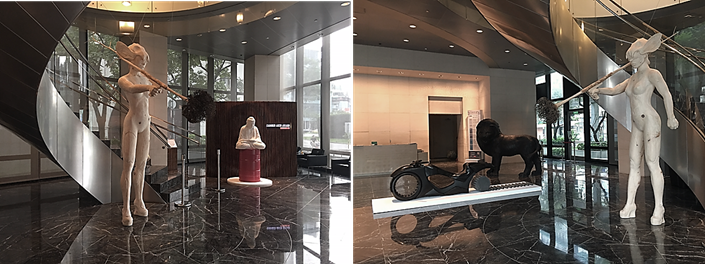- Date 2017.09.06
- Venue 1F Lobby of Taishin Holding
Zone Out—CHANG Nai-Wen

Zone Out: CHANG Nai-Wen Solo Exhibition
Dates: 9.11 - 10.20, 2017
The mind seems to zone out here because sculpture is grounded in materiality yet its meaning is relatively ambiguous and uncertain. This beckons at the fact that modern man's spirituality is in a state of loss and destitute. —— Chang Nai-Wen
As the autumn comes, Taishin Bank Foundation for Arts and Culture invites artist Chang Nai-Wen to lead the audience to examine contemporary cultural phenomena through his sculptures. Ceremonious Nod portrays Vairocana Buddha dozing off, suggesting the cease of the light. Manjusri is Absent symbolizes a lack of wisdom. The back of Avalokitesvara is laid bare, through which the artist aims to discuss the ancient Chinese aesthetics created by sculptor Cao Zhongda with his "unique technique of delineating tightly bound clothes." Future presents a future created by the goddess of lust. The motorcycle and lion become rides and are compared to the plinths used by artists, pointing to this time when art is a plaything for anyone. Moreover, the motorcycle's tire has come off, symbolizing art's uselessness in the contemporary world.
When these images are brought together and each of them represents a different time and space, viewers' sense of time is sometimes cast into the future and sometimes brought back to the time gone by. It suggests a forward leap of time as well as how time regresses into the past in the form of delay and procrastination. In contemporary art, this usually refers to a secularized cultural world. However, through the configuration of these images, viewers seem to be placed in a "jet-lagged" cultural consciousness.
Artist / CHANG Nai-Wen
Born in Tainan, Taiwan, Chang Nai Wen is an Associate Professor at Taipei National University of the Arts.
Early in his career, Chang employed the abstract form to create his sculptures; later, he gradually shifted towards making sculptures of concrete images, incorporating traditional religious images into his work and developing a unique sculptural language. He was awarded the Grand Prize of the 2nd Prix de Paris and the Taipei Award of the 26th Taipei Exhibition of Fine Arts
